VF-9 "RAPTOR-II"
(Version 1.00 - Last updated:
11/12/00)
- Background and RPG Statistics by Kenneth
Olson
- Background Information
derived from Robotech Technical
Files
BACKGROUND
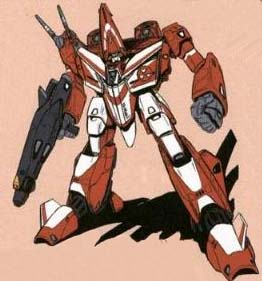 After
the end of the First Robotech War and the beginning of the rearmament period leading up to
the Sentinels campaigns, RDF designers came out with a plethora of new designs for any
conceivable enemy. As early as 2015, the newly formed Robotech Expeditionary Force
decided that the new generation of Robotech fighters for the upcoming trip to the home
world of the Robotech Masters was needed. Design teams from the Tokyo
Robotech Research facility designed and produced a radical new veritech fighter
to replace the VF-4 Lighting. The new fighter
would be armed with the latest weaponry and armored using the more advanced Chobam
designs.
After
the end of the First Robotech War and the beginning of the rearmament period leading up to
the Sentinels campaigns, RDF designers came out with a plethora of new designs for any
conceivable enemy. As early as 2015, the newly formed Robotech Expeditionary Force
decided that the new generation of Robotech fighters for the upcoming trip to the home
world of the Robotech Masters was needed. Design teams from the Tokyo
Robotech Research facility designed and produced a radical new veritech fighter
to replace the VF-4 Lighting. The new fighter
would be armed with the latest weaponry and armored using the more advanced Chobam
designs.
The fighter mode of the VF-9 outwardly was taken from the experimental
X-29. Two new Nakajima/P&W/Rolls-Royce FX-2005 fusion turbines were added to
replace the venerable FF-2001. These engines
produced 25% more thrust than the earlier models at three-quarters the weight. The
aging Hughes AWG-20 X-band pulse-Doppler radar was replaced with a new
Westinghouse APS-150 X-band pulse Doppler AWG-30 model
providing 50% greater detection range.
The incredible maneuverability and the upgraded weaponry and armor of the
VF-9 made the Raptor a formidable opponent. The armor was upgraded to the Chobam laminar
mounted on the VBF-9 and VAF-6 series of veritech fighters. The missile complement was kept from the
older VF series; however, the new GU-111 65mm rotary cannon was added for additional
firepower. The GU-111 is mounted underneath in fighter mode and on the
right arm in guardian and battloid mode. Two LA-5 lasers were mounted on
the shoulders to allow the the APS-150 to be positioned on the head.
Each LA-5 is capable of firing 6 MJ bursts every 2 seconds. Although, the
LA-5s are available in any mode they are rarely used in battloid
configuration because of the awkward positioning. However, on a few
experimental units the lasers were controlled by the weapons computer to provide
automatic anti-missile protection. Two 50mm EP-5 particle beam
cannons are mounted on both arms. Each EP-5 is capable of firing 20 MJ
bursts up to 20 times per minute and are capable of firing in every
mode.
The first production model was rolled out in July of 2017 and under went
flight testing at the RDF New Albuquerque base. The Raptor proved to be a
superior unit to the VAF-6 in the atmosphere; albeit somewhat under gunned in comparison
to the VAF-6 and the VBF-9. The REF high command was sufficiently
impressed to order 250 units produced for use in REF marine divisions.
Raptors would be dropped from orbit to provide air support for marine destroid
units along with the more venerable VF-4. Through out the Sentinel
campaign the VF-9 proved to be a superior atmospheric unit capable of out
maneuvering the Invid Armored Scouts. The REF high command would have
liked to produce additional units; however, priorities were placed on VAF-6 and
VBF-9 starship construction. As a results, by the time of the final
assault on Opterra only 107 VF-9s were available for the final assault.
Most of these units were rendered inoperative during the assault and they were
not replaced as the REF marines began to receive VAF-6 alpha fighters to replace
the VF-9. Only a single squadron of 15 VF-9s were used to supplement REF
force during the campaign to liberate the Earth from the Invid Regis.
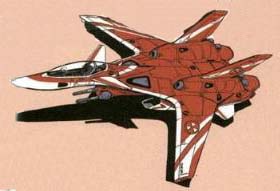
RPG STATS
- Vehicle Type: VF-9 Raptor
- Class: Variable Fighter
Manufacturer: Robotech Defense Forces
Crew: One pilot wearing Tactical Life Support System.
MDC BY LOCATION:
| Location |
Raptor |
| Small Head Lasers (2) |
25 |
| Head Sensor Probe (1) |
35 |
| * Head |
125 |
| Hands (2) |
30 |
| Arms (2) |
125 |
| Legs/Engine Thrusters |
225 |
| ** Main Body |
300 |
| Reinforced Pilots Compartment |
200 |
| Retractable Utility Arms |
3 |
| Wings (2) |
125 |
| Tails (2) |
50 |
| GU-111 |
100 |
NOTES:
- * Destroying the head of the Raptor will knock out the mecha's major sensor
systems, including all of the optics systems (infrared, nightvision,
thermal), and the APS-150 Radar System.
- ** Depleting the MDC of the main body will destroy the mecha.
SPEEDS:
- RUNNING, SOLDIER CONFIGURATION:
- 140 kph
- LEAPING, SOLDIER CONFIGURATION:
- 50 ft (15 m) high or 70 ft (21 m) long without thrusters.
- FLYING, SOLDIER CONFIGURATION:
- 350 kph
- FLYING, GERWALK/SOLDIER CONFIGURATION:
- Mach One (670 mph/1072 kmph) maximum speed limit in an Earth-like atmosphere. Can also
hover in place indefinitely.
- FLYING, FIGHTER CONFIGURATION:
- Max level speed at sea level : Mach 1.6
Max level speed at 10km: Mach 5.0
Max level speed at 30+ km: Mach 8.0
- Stall speed : 150 kph (VTOL rectification possible)
Initial climb rate : over 35000m per minute
Service ceiling : 40 km (unboosted).
MAX ENGINE THRUST:
- Two Nakajima/P&W/Rolls-Royce FX-2005 fusion turbines, total engine
output 325 kN total at max. power; 610 kN are available with overboost. Exhaust nozzles
allow for vector thrust, serving in place of conventional elevators. System includes two
reverse-vernier thrusters, on blisters outboard of each intake; exhaust comes directly
from main turbine at a maximum of 20% thrust.
- Four Nakajima NBS-1 high-thrust vernier thrusters, four in the legs on
the ventral in fighter mode, two in the 'backpack' in Guardian and Battloid modes.
Each thruster has a total engine output of 50 kN.
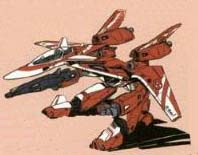 STATISTICAL DATA:
STATISTICAL DATA:
- HEIGHT:
- 17.7m in soldier configuration.
- 12.3m in gerwalk configuration.
- 6.5m in fighter configuration.
- WIDTH:
- 10.1m at shoulders in soldier and gerwalk configuration.
- 14.8m with wings at maximum extension.
- LENGTH:
- 5.5m in soldier configuration.
- 12.3m in gerwalk configuration.
- 15.1m in fighter configuration.
- WEIGHT:
- 27,200 kg empty.
- PHYSICAL STRENGTH:
- Equal to a P.S. of 60
- CARGO:
- Small compartment behind pilot's seat for personal belongings in addition to the cyclone
storage compartment
- POWER PLANT:
- Two Tirolian mecha protoculture-generators RT-5d providing a total of 800 MW
- Delta V:
- 100 kps
- COMPATIBLE FAST PACKS:
- None
-
WEAPON SYSTEMS:
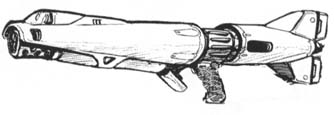
- GU-111 65MM THREE-BARRELED SMOOTHBORE
ROTARY: firing 700 rounds per minute, 600 round capacity stored internally.
- PRIMARY PURPOSE: Assault
- SECONDARY PURPOSE: Anti-Mecha
- RANGE: Armor Piercing Spin Stabilized Discarding Sabot (APSSDS) 5249 feet (1600
m), or 3937ft (1200m) for all others.
- DAMAGE: APSSDS 6d6 short burst, 1d4*10+10 medium burst, 3d4*10+10 full melee
burst. HEAP 1d4*10 short burst, 2d4*10 medium burst, 4d4*10 full melee burst.
Tracer rounds reduce damage by 25%. Standard 5d6 short burst, 1d4*10 medium burst,
or 3d4*10 full melee burst
- RATE OF FIRE: Single shots or bursts equal to the combined attacks of the pilot.
- PAYLOAD: 600 rounds of internal ammunition or 60 short bursts, 30 medium, or 15
full melee.
- NOTES: APSSDS critical strikes on 17,18,19,20. HEAP
critical strikes on 19,20.
Tracers add +2 to strike.
- EP-5 50MM SINGLE BARREL PARTICLE CANNON: Two EP-5 particle beam
cannons are mounted in either arm. The EP-5 is capable of firing 20 MJ
bursts up to 20 times per minute, with power coming directly from the main
protoculture generators. The EP-5 was met to be a replacement for the
aging GU-11 gun pod and as such performed well. The EP-5 is an
upgraded version of the EP-4 found on the VF-4 "Lightning".
The gun is powered directly from the main protoculture generators and as
such the rate of fire is only limited by the recharge rate. In fighter
and gerwalk mode the EP-5 are mounted foward, while in battloid mode the
weapons are mounted in the arms.
- PRIMARY PURPOSE: Assault
- SECONDARY PURPOSE: Anti-Mecha
- RANGE: 2000 m
- DAMAGE: 2D4*10 per single shot
- RATE OF FIRE: Single shots equal to the combined attacks of the
pilot up to 5 times per melee.
- PAYLOAD: Effectively unlimitted
- LA-5 LASERS: The standard head lasers found on the VF-1 were moved
to the right arm to allow the APS-150 X-band pulse Doppler sensor on the
head. Each LA-5 laser cannon is capable of firing 6 MJ shots every two seconds.
On some experimental units, the LA-5 were modified to allow the combat
computer to automatically fire at incoming missile volleys. However,
this modification was not implemented in the standard unit because of the
perceive fear that the computer would accidentally hit friendly units in the
process of destroying any incoming missiles.
- PRIMARY PURPOSE: Anti-missile
- SECONDARY PURPOSE: Assault
- RANGE: 600 m
- DAMAGE: 4d6 for each Head lasers or 8d6 if both are fired
- RATE OF FIRE: Single shots equal to the combined attacks of the pilot up to eight
times per melee.
- RATE OF FIRE (anti-missile): The combat computer is
capable of firing at four missiles per melee.
- PAYLOAD: Conditionally unlimited.
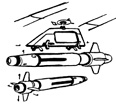
- BODY/WING HARD POINTS: Two fixed hard points are mounted on each wing.
These hardpoints can be used to carry 15 short range missiles, 5 medium range
missiles or 2
long range missiles.
- HAND TO HAND COMBAT: If necessary, the Raptor can engage in melee combat
rather than use a weapon. The VF-9 is extremely agile and can execute most
typical hand to hand combat moves, such as punches, jump kicks, leap attacks, rolling with
impacts, etc.
DAMAGE:
- Punch in Battloid: 3D6*3
- Punch in Guardian: 3D4*3
- Kick: 3D6*3
- Leap Kick: 6D6*3
- Body Flip/Throw: 3D6*3
- Body Block/Tackle: 3D6*3
- Stomp: 6D6*3 . (only effective against small objects)
STANDARD EQUIPMENT FOR THE RAPTOR:
- AUTO-PILOT: The Raptor is equipped with a computerized auto-pilot, allowing
the pilot to relax or even sleep during long voyages. The auto- pilot can be programmed
with a single destination or a complex flight plan involving multiple speeds, directions,
and destinations. The onboard computer will alert the pilot when the fighter is near its
destination, and can also be set to automatically signal when sensors detect objects near
the mecha. The auto-pilot was designed with long intra-system space journeys in mind.
- TACTICAL LIFE SUPPORT SYSTEM: The Raptor cockpit is pressurized, and also
provides additional air feeds to the pilot's flight suit that provides him with
pressurized breathing. The REF flight suit also contains an upper and lower g-suit that
promotes blood circulation even during high-g turns, thus decreasing the possibility of
pilot's blacking out in combat.
- TI-1000 COMBAT COMPUTER: The combat computer tracks and identifies specific enemy
targets, and has a database of over 10,000 images stored in memory. The computer can
identify and track up to 250 targets simultaneously.
- EXTERNAL AUDIO PICKUP: Range: 300 ft (91.5 m). A sound amplification system that
can pick up normal conversation up to 300 feet away.
- HEAT AND RADIATION SHIELDS: Special shielding prevents the penetration of life
threatening head and radiation. A radiation detection and alarm system are linked with the
shields and will sound an alarm if there is a rupture in the shields and what the levels
of radiation are.
- HOMING SIGNAL: The escape pod of the VF-9 is equipped with a
homing device that enables rescue teams to locate a disabled craft or ejected life pod.
The range of the signal is 400 miles (640 km). Most REF ships and veritechs can locate and
track a homing signal, and the onboard computers will automatically notify their pilots if
such a signal is detected.
- LASER TARGETING SYSTEM: Range: 100 miles (160 km). Used for increased accuracy in
the striking of enemy targets and is partly responsible for the mecha's strike bonus.
- LOUDSPEAKER: A loudspeaker system is built into the craft, which can be used to
amplify the pilot's voice up to 90 decibels.
- OPTICS: INFRARED: Range: 2000 feet (610 m). This optical system projects a beam
of infrared light that is invisible to the normal eye, but detectable by the mecha's
sensors. The system allows the pilot to detect hidden/concealed objects by their IR
reflectiveness. The beam will be visible to anyone with IR sensitive optics, however.
- OLDELFT INFRA-RED WARNING RECEIVER (IRWR)
- OPTICS: NIGHTVISION: Range: 2000 feet (610 m). A passive light image intensifier
that emits no light of its own, but relies on ambient light which is electronically
amplified to produce a visible picture.
- OPTICS: THERMAL IMAGER: Range: 2000 feet (610 m). A passive optical heat sensor
that detects infrared radiation projected by warm objects and converts that data into a
false-color visible image. The system enables the pilot to see in the dark, in shadows,
and through smoke, and also adds a +10% bonus to pilots using a tracking skill.
- APS-150 X-BAND RADAR: The APS-150 is mounted on the
head of the Raptor. The unit was specially designed for the Raptor and
has a 200 mile range.
- ELETTRONICA RADAR WARNING RECEIVER (RWR)
- WESTINGHOUSE ALQ-250(V) ACTIVE SENSOR JAMMER
- CHAFF AND FLARE DISPENSERS: 12 chaff and 12 flares are stored in each
lower leg
- RADIO/VIDEO COMMUNICATION: Long range, directional communications system with
satellite relay capabilities. Range: 600 miles (960 km) or can be boosted indefinitely via
satellite relay.
- SELF-DESTRUCT: To prevent capture of an advance variable fighter by the enemy,
the pilot can activate the VF-9 self-destruct system, which will cause the fighter
to explode after a delay of up to 60 minutes (time is set by the pilot). The explosive
damage is contained within a 20 foot (6 m) area and inflicts 1D6x10 M.D. to everything
within the radius of the explosion. All internal systems are obliterated. The escape pod
will be automatically ejected prior to the explosion unless the pilot overrides the
ejection sequence.
- STANDARD SURVIVAL KIT: All RDFs veritechs come equipped with a portable survival
kit. Inside the small reinforced box is a medium-sized flashlight, two hand flares, one
rocket flare, a compass, infrared distancing binoculars, a small mirror, a pocket knife,
dehydrated and concentrated food (can be stretched into a five day supply for one person)
and basic first aid items (aspirin, bandages, disinfectants, etc.)
COMBAT BONUSES FOR RAPTOR TRAINING:
- 3 attacks per melee (plus those of the pilot).
- Add one additional action/attack at levels six and eleven.
- +2 to strike
- +2 to parry
- +2 to dodge in solder, +4 in guardian, and +6 (+7 in the atmosphere) in jet mode.
- +3 to roll with a punch or fall with an impact, reducing damage by half.
- Critical strike same as pilot's hand-to-hand.
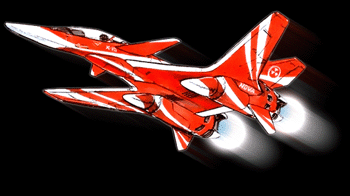 REFERENCES USED IN THIS DESIGN
REFERENCES USED IN THIS DESIGN
- Robotech Technical Files: Veritech Valkyrie
- Palladium Books: "Robotech The Roll Playing Game"
Back to Mecha Home
 After
the end of the First Robotech War and the beginning of the rearmament period leading up to
the Sentinels campaigns, RDF designers came out with a plethora of new designs for any
conceivable enemy. As early as 2015, the newly formed Robotech Expeditionary Force
decided that the new generation of Robotech fighters for the upcoming trip to the home
world of the Robotech Masters was needed. Design teams from the Tokyo
Robotech Research facility designed and produced a radical new veritech fighter
to replace the VF-4 Lighting. The new fighter
would be armed with the latest weaponry and armored using the more advanced Chobam
designs.
After
the end of the First Robotech War and the beginning of the rearmament period leading up to
the Sentinels campaigns, RDF designers came out with a plethora of new designs for any
conceivable enemy. As early as 2015, the newly formed Robotech Expeditionary Force
decided that the new generation of Robotech fighters for the upcoming trip to the home
world of the Robotech Masters was needed. Design teams from the Tokyo
Robotech Research facility designed and produced a radical new veritech fighter
to replace the VF-4 Lighting. The new fighter
would be armed with the latest weaponry and armored using the more advanced Chobam
designs.
 STATISTICAL DATA:
STATISTICAL DATA:

 REFERENCES USED IN THIS DESIGN
REFERENCES USED IN THIS DESIGN